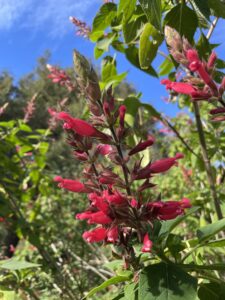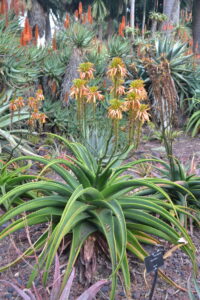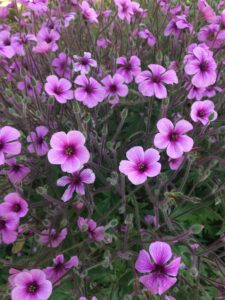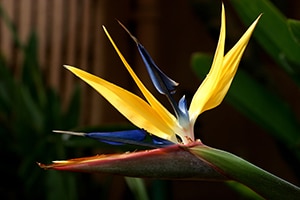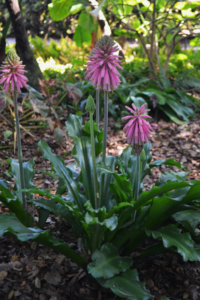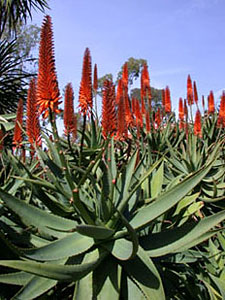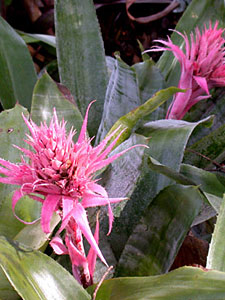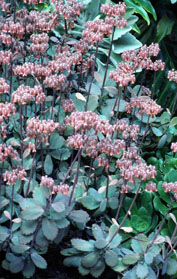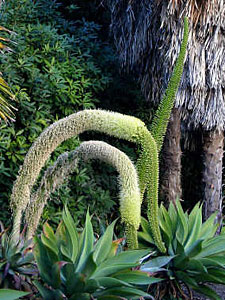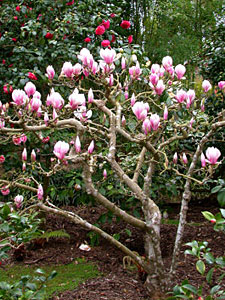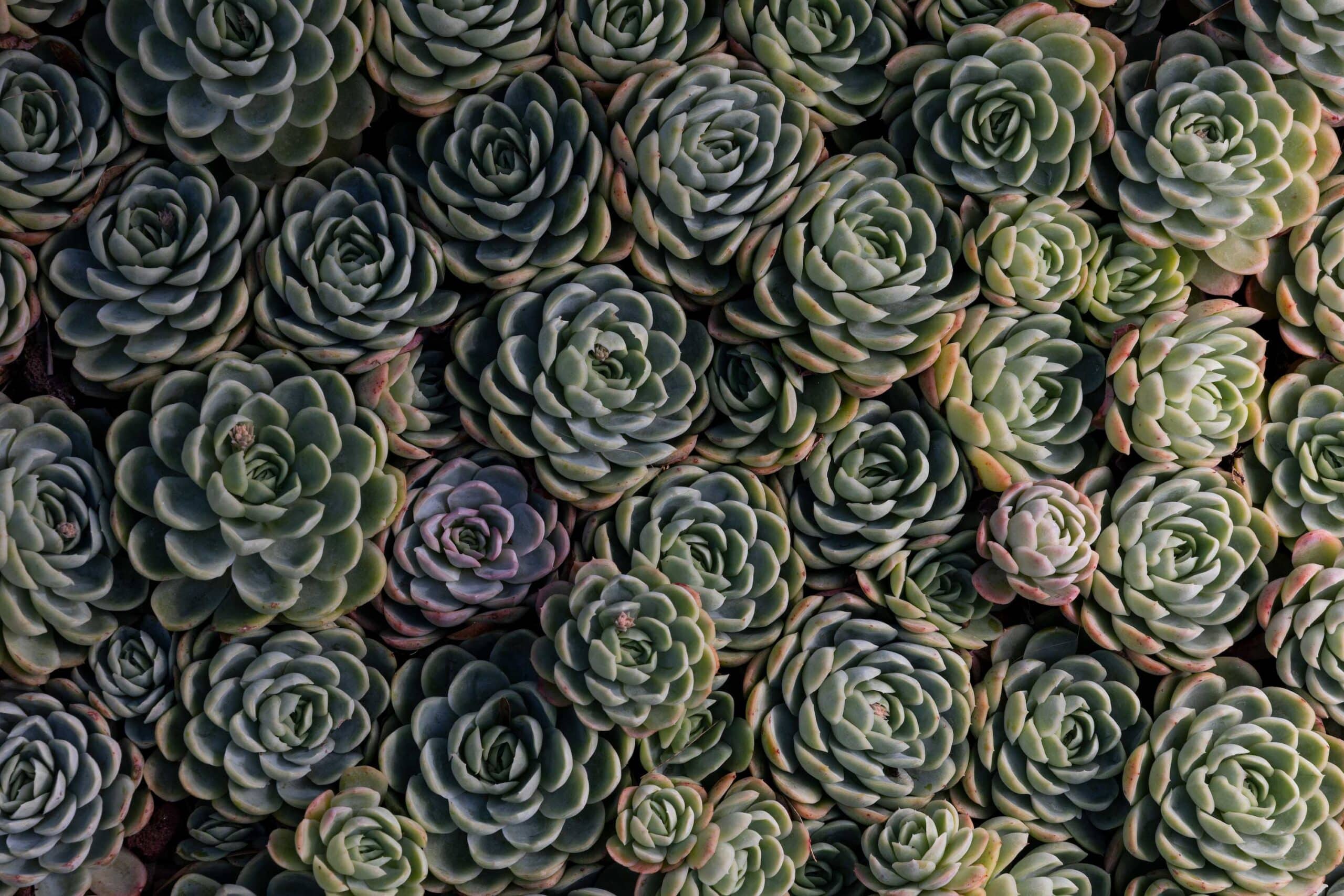
Plant Highlights
February
-
Salvia ‘Carol’s Delight’
Carol Terry’s sage
Highlight Month:
February
Nativity:
Garden Origin
Growth Habit:
Salvia ‘Carol’s Delight’ is a late season bloomer with a tall stature. Mature plants can reach heights of 6-10’ and 6-8’ wide and display bright crimson flowers from September to March in Santa Barbara.
Growing Requirements:
Salvia ‘Carol’s Delight’ is hardy to 27°F but will resprout from the base if exposed to colder temperatures. It prefers full to part sun and is tolerant of dry conditions once established.
Features:
This salvia is a presumed hybrid of Salvia karwinskii and S. wagnerianum that arose as a chance seedling in the garden of Carol Terry in the early 90’s. She didn’t notice the plant until it bloomed above the canopy of the apple tree it had germinated under. Both suspected parents are native to southern Mexico into Central America and have pink flowers. This hybrid strongly resembles S. wagnerianum and has a longer blooming time than either of these two species.
Salvia ‘Carol’s Delight’ is named after Carol Terry, current Lotusland Bromeliad Garden volunteer. Carol was previously the Santa Barbara City Parks Gardener of Alice Keck Park Memorial Garden for 12 years and former President of the Santa Barbara Horticultural Society. The genus name, Salvia, comes from the Latin, salvus, meaning “to make safe or healthy” in reference to the healing properties of many sages.
Where at Lotusland:
This plant can be found in the Insectary Garden at Lotusland where it is loved by pollinators, including hummingbirds.
-
Aloe lukeana
Luke’s aloe
Highlight Month:
February
Nativity:
Aloe lukeana is found in northeastern Uganda and South Sudan.
Growth Habit:
It displays striking red to orange flowers in late summer-early winter that are held upright before becoming pendant. This large solitary Aloe will reach 3-4’ wide and form a decumbent rosette that grows along the ground. This species is relatively new to cultivation but observations in the wild indicate it eventually forms an upright trunk and may branch with age.
Growing Requirements:
Well-drained soils and full sun.
Features:
This Aloe was first described in 2015 by Tom Cole, owner of Cold Spring Aloes, humanitarian/agricultural aid worker, and Lotusland neighbor. It is named in honor of his late brother, Luke Cole, an environmental justice lawyer and conservationist who tragically died while exploring Uganda in 2009.
Where at Lotusland:
Aloe Garden
-
Geranium maderense
Madeira Island geranium
Highlight Month:
February
Nativity:
Island of Madeira off the northwest coast of Africa
Growth Habit:
It is a biennial and produces a flush of tropical-looking leaves about 3’ wide during its first year, and a massive many-branched inflorescence with bright pink flowers its second year.
Growing Requirements:
This geranium can tolerate dry, clay soils and is adaptable to sun or shade.
Features:
Flower stalks and sepals are covered in purple glandular hairs that prolong its spring interest. Be sure to leave the lower leaf stalks because they form a mound of stilts to prop up the stem.
Where at Lotusland:
Fern Garden- where both the straight species and the cultivar ‘Alba’, a white-flowered form grow.
-
Strelitzia reginae ‘Mandela’s Gold’
Mandela’s Gold yellow bird-of-paradise
Highlight Month:
February
Nativity:
Garden Origin (Kirstenbosch National Botanical Garden, South Africa)
Growth Habit:
Evergreen, clump-forming, 4-5′ tall
Growing Requirements:
Bird of paradise plants are quite drought tolerant once established. Plant in full sun near the coast or partial shade in hotter regions.
Features:
This yellow-flowering form was created at Kirstenbosch Botanical Garden by careful cross-pollination of rare yellow flowers on the typically orange-flowering species.
Where at Lotusland:
At the top of the Parterre in front of the wrought iron wishing well, adjacent to the circular pebble mosaics.
-
Veltheimia bracteata
forest lily, cape lily
Highlight Month:
February
Nativity:
South Africa (S. Cape Province)
Growth Habit:
This bulb displays glossy green foliage followed by a one-foot tall inflorescence bearing tubular bubblegum pink flowers in late winter/early spring.
Growing Requirements:
Veltheimia bulbs should be planted in autumn in moist, well-drained soil. They grow best in partial to full shade with regular water during growing season, less after flowering.
Features:
Each flower head will last up to a month, then will be followed by inflated green seed capsules. The seeds can be harvested once the capsules dry out and the seeds turn black. Mature bulbs make offsets that can be divided or left in the ground to spread. Plants often go summer dormant in warmer climates and are frost tender.
Where at Lotusland:
Fern Garden
-
Aloe arborescens
candelabra aloe
Highlight Month:
February
Nativity:
South Africa
Growth Habit:
A clumping perennial with groups of stems spreading 10 feet tall and 6 feet wide.
Growing Requirements:
Shade to partial sun, moderate water. It can adapt to a wide variety of soil types.
Features:
A. arborescens has spikes of deep red flowers which bloom profusely through the winter months. It is one of more common aloe seen in Santa Barbara.
Where at Lotusland:
There are many specimens of A. arborescens throughout the Aloe Garden. There is also a planting along the Main Drive by the Sycamore Canyon gate.
-
Aechmea fasciata
Highlight Month:
February
Nativity:
Brazil
Growth Habit:
The vase-like rosette of leaves of this bromeliad is gray-green with a row of black spines along the margins. Plants produce bright pink inflorescences after several years. While the original plant will die after flowering, it will produce several offsets that may be removed and replanted. It is usually epiphytic in its native range, but adapts well to containers or raised beds outdoors.
Growing Requirements:
Grow Aechmea fasciata in bright shade either in a pot or in the ground with lots of organic material incorporated into the soil mix. Soil may be allowed to dry out between waterings, but maintain the central cup – made by the tightly overlapping leaves – full of water at all times. Fertilize every month or two with half-strength liquid fertilizer in the central cup.
Features:
This bromeliad is probably one of the best known and easiest to grow. It is regularly available in nurseries, home improvement centers and supermarkets.
Where at Lotusland:
There are a number of plants in both the Upper and Lower Bromeliad Gardens.
-
Kalanchoe fedtschenkoi
lavender scallops
Highlight Month:
February
Nativity:
Central & S. Central Madagascar
Growth Habit:
This succulent-leaved plant forms sturdy stems that are topped with clusters of nodding, bell-shaped flowers. They are an interesting shade of dusky rose that contrasts nicely with the bluish gray of the leaves. In winter, when the flowers are emerging, the leaves may also take on a reddish tinge because of the cold.
Growing Requirements:
This kalanchoe is readily propagated from stem cuttings or by simply sticking the base of a leaf in well-drained soil. Grow in full sun to moderate shade. It is very drought tolerant and requires no supplemental water once established.
Features:
The flattened leaves are scalloped along the margins and are often held at an optimum angle toward the sun, making the whole plant look two dimensional.
Where at Lotusland:
Growing at the base of the tall Kalanchoe beharensis plants near the bromeliads and succulents.
-
Agave attenuata
foxtail agave
Highlight Month:
February
Nativity:
Mexico (México State, Central Jalisco, Michoacán)
Growth Habit:
This agave is among only a few that do not have sharp spines along the edges or at the tip of its leaves. The leaves are soft and light green forming rosettes up to four feet across. It often branches near the base of a stalk to form larger clumps. The inflorescences arch up and then toward the ground and individual flowers bloom in succession from the base to the tip over a long period. A blue-leaved selection (Agave attenuata ‘Boutin Blue’) has erect inflorescences. Both types often produce many little plantlets along the spent flower stalk that will root on the ground if given the chance.
Growing Requirements:
Agaves are by and large desert plants. Their succulent leaves store water through dry periods making them extremely drought tolerant. Give them good drainage and a sunny or only slightly shaded site.
Features:
The bold rosettes of leaves provide a good accent plant in the drought tolerant garden. They even blend well with more tropical looking plants.
Where at Lotusland:
Lining the Main Drive just inside the Sycamore Canyon Gate. ‘Boutin Blue’ grows in the Blue Garden and a variegated form grows in the Pavilion Patio.
-
Magnolia x soulangeana
saucer magnolia
Highlight Month:
February
Nativity:
Garden Origin
Growth Habit:
This deciduous magnolia may grow as a multi-trunked or single-stemmed bush. It usually grows 10 to 15 feet in height. Flowers appear in early spring before the glossy green leaves.
Growing Requirements:
While perfectly happy in our Mediterranean climate, this magnolia will also thrive in temperate climates. Likes regular water and rich, well-amended soil.
Features:
The showy flowers are cup shaped, reddish purple on the outside shading to nearly white on the inside. It is a hybrid of Magnolia denudata and M. liliiflora.
Where at Lotusland:
Japanese Garden


